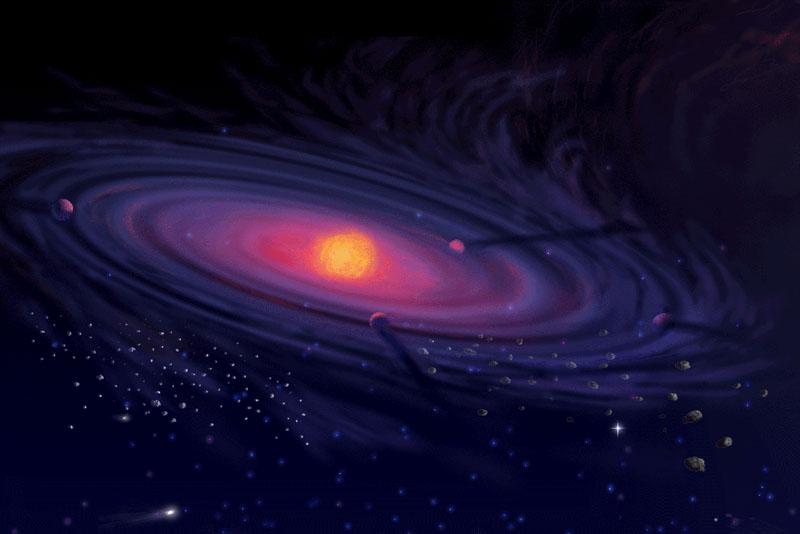7. The Formation of Our Solar System (4.6 Ga)
Summary Our Solar System, that is the Sun and the astronomical bodies orbiting it, was formed 4.6 billion years ago by a collapsing interstellar gas cloud. The largest bodies orbiting the Sun are the eight planets of our Solar System, one of which is the Earth, which were formed by coalescing heavy elements which had been created by massive stars. The Sun will gradually become hotter and larger in the next about 5 billion years, after which it will become unstable and ultimately die.
Keywords Chemistry; Interstellar Medium; Planets; Stars

An artist’s impression of a protoplanetary disk around a young star. In the protoplanetary disk heavy elements coalesce to dust grains, to rocks, to planetesimals and ultimately to planets. (© Pat Rawlings, NASA / Wikimedia Commons / Public Domain)
After the first generation of stars had died and enriched the interstellar medium with heavy elements, 4.6 billion years ago – that corresponds to 9.2 billion years after the Big Bang – a cold and dense cloud of the interstellar medium, which was about 65 light-years across, fragmented and collapsed into dense cores, an event which was certainly triggered by the shock wave from a nearby star explosion. One of these dense cores was the pre-solar nebula from which our Solar System formed, while other dense cores formed other solar systems. Most of the material in the pre-solar nebula diffused towards the center due to the gravitational attraction and formed the Sun, which today contains 99.8% of the mass in our Solar System. Around the Sun a disk formed out of the remaining material, the so-called protoplanetary disk. The protoplanetary disk was hotter and denser towards its center, and in it heavy elements coalesced to dust grains, which clumped together to form rocks, which then collided with each other to form planetesimals, which were the ancestors of the planets in our Solar System. Such the planet formation was only possible as heavier elements had been created by massive stars before.

The major bodies in our Solar System. From left to right: The Sun; the four terrestrial planets Mercury, Venus, Earth and Mars; and the giant planets Jupiter, Saturn, Uranus and Neptune. The sizes are to scale, but distances are not. (© WP / Wikimedia Commons / CC-BY-SA-3.0)
Today the planets of our Solar System can be categorized into two types, the terrestrial planets similar to the Earth and the giant planets similar to Jupiter. The four terrestrial planets Mercury, Venus, Earth and Mars are close to the Sun, mainly consist of rocks and are comparably small. The four giant planets Jupiter, Saturn, Uranus and Neptune, on the other side, are far away from the Sun, mainly consist of low-boiling-point materials and are comparably large. Jupiter, with a mass of 318 times the mass of the Earth and a radius of 11 times the radius of the Earth, is the largest planet in our Solar System. At least 79 moons are orbiting Jupiter, of which the first four were discovered by Italian astronomer Galileo Galilei in 1610. The four giant planets contain around 99% of the mass orbiting the Sun and are responsible for more than 99% of the angular momentum in the whole Solar System. While the Earth has an average distance of 150 million kilometers from the Sun, the so-called astronomical unit which is equivalent to eight light minutes, Neptune orbits the Sun at a far larger average distance of 30 astronomical units.
The giant planets can also be subcategorized into the gas giants, these are Jupiter and Saturn which mainly consist of the lightweight elements hydrogen (H) and helium (He), and the ice giants, these are Uranus and Neptune which mainly consist of water (H2O), ammonia (NH3) and methane (CH4). The gas giants are larger than the terrestrial planets, as during the formation of our Solar System the protoplanetary disk was colder in its outer regions, which let low-boiling-point materials condense beyond the so-called frost line and such participate in the planet formation. While the terrestrial planets and the gas giants are visible at the night sky and were known to humankind since ancient times, the ice giants were only discovered after the invention of the telescope: Uranus in 1781 and Neptune in 1846.
Apart from the eight planets our Solar System also comprises the asteroid belt between the most outward terrestrial planet Mars and the most inward giant planet Jupiter. Asteroids are rocks floating through space with sizes ranging from one meter to a few hundreds of kilometers. The asteroid belt also comprises the dwarf planet Ceres, with a dwarf planet being an astronomical body which is large enough to have a spherical shape due to its gravitational self-attraction but which could not clear its orbit around the Sun from other objects such as asteroids. Additionally, in our Solar System there are several trans-Neptunian opjects, among them the dwarf planets Pluto and Eris, and numerous comets which are asteroids with a few attached gases.
The Sun will gradually become bigger and hotter during the next about 5 billion years, which will result in all Earth oceans being evaporated in around 2 billion years. After that time the Sun will have fused all hydrogen atomic nuclei in its core and will become a red giant star. In that phase it will become very large, probably bigger than Earth’s current orbit around the Sun. After a few turbulent short-lived phases and all useable nuclear fuel is used up, the Sun will ultimately contract, become much cooler and become a white dwarf. This will result in a very cold Earth – if it still exists –, as the Sun’s radiation is the major energy source on the Earth’s surface.
